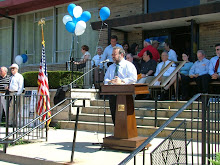Published 02:11 10.06.11Latest update 02:11 10.06.11
Reclaiming a historical truth
The deliberate depopulation of Arab villages was a hallmark of the Arab campaign. In December 1947, villagers in the Tul Karm sub-district were ordered out by local leaders.
By Efraim Karsh
I agree with Shlomo Avineri, in his op-ed "Zionism needs no propaganda" (Haaretz English Edition, May 23 ), that the tragedy befalling the Palestinian Arabs in 1948 was exclusively of their own making, and that there is therefore "a grave moral defect in the Nakba discourse."
I am surprised, however, by his assertion that "despite decades of research, to this day no document or broadcast has been found confirming ... [any order] by the Arab leadership for the population to leave." This claim couldn't be further from the truth. While most Palestinian Arabs needed little encouragement to take to the road, large numbers of them were driven from their homes by their own leaders and/or the "Arab Liberation Army" that had entered Palestine prior to the end of the Mandate, whether out of military considerations or in order to prevent them from becoming citizens of the prospective Jewish state. Of this there is an overwhelming and incontrovertible body of contemporary evidence - intelligence briefs, captured Arab documents, press reports, personal testimonies and memoirs, and so on and so forth.
In the largest and best-known example of Arab-instigated exodus, tens of thousands of Arabs were ordered or bullied into leaving the city of Haifa (on April 21-22 ) on the instructions of the Arab Higher Committee, the effective "government" of the Palestinian Arabs. Only days earlier, Tiberias' 6,000-strong Arab community had been similarly forced out by its own leaders, against local Jewish wishes (a fortnight after the exodus, Sir Alan Cunningham, the last British high commissioner of Palestine, reported that the Tiberias Jews "would welcome [the] Arabs back" ). In Jaffa, Palestine's largest Arab city, the municipality organized the transfer of thousands of residents by land and sea; in Jerusalem, the AHC ordered the transfer of women and children, and local gang leaders pushed out residents of several neighborhoods, while in Beisan the women and children were ordered out as Transjordan's Arab Legion dug in.
Avineri mentions the strenuous Jewish efforts to persuade the Haifa Arabs to stay but not the AHC's order to leave - which was passed on to the local leadership by phone and secretly recorded by the Haganah. Nor does he note the well-documented efforts of Haifa's Arab leadership to scaremonger their hapless constituents, reluctant in the extreme to leave, into fleeing. Some Arab residents received written threats that, unless they left town, they would be branded as traitors deserving of death. Others were told they could expect no mercy from the Jews.
In the words of a British intelligence report: "After the Jews had gained control of the town, and in spite of a subsequent food shortage, many would not have responded to the call for a complete evacuation but for the rumors and propaganda spread by the National Committee members remaining in the town. Most widespread was a rumor that Arabs remaining in Haifa would be taken as hostages by [the] Jews in the event of future attacks on other Jewish areas: and an effective piece of propaganda with its implied threat of retribution when the Arabs recapture the town, is that [those] people remaining in Haifa acknowledged tacitly that they believe in the principle of a Jewish State."
Nor was this phenomenon confined to Palestinian cities. The deliberate depopulation of Arab villages too, and their transformation into military strongholds was a hallmark of the Arab campaign from the onset of hostilities. As early as December 1947, villagers in the Tul Karm sub-district were ordered out by their local leaders, and in mid-January Haganah intelligence briefs reported the evacuation of villages in the Hula Valley to accommodate local gangs and newly arrived ALA forces.
By February, this phenomenon had expanded to most parts of the country, gaining considerable momentum in April and May as Arab forces throughout Palestine were being comprehensively routed. On April 18, the Haganah's intelligence branch in Jerusalem reported a fresh general order to remove the women and children from all villages bordering Jewish localities. Twelve days later, its Haifa counterpart reported an ALA directive to evacuate all Arab villages between Tel Aviv and Haifa in anticipation of a new general offensive. In early May, as fighting intensified in the eastern Galilee, local Arabs were ordered to transfer all women and children from the Rosh Pina area, while in the Jerusalem sub-district, Transjordan's Arab Legion ordered the emptying of scores of villages.
To sum up, Zionism needs no propaganda to buttress its case, yet the historical truth needs to be reclaimed after decades of relentless distortion.
Efraim Karsh is research professor of Middle East and Mediterranean studies at King's College London, director of the Middle East Forum (Philadelphia ) and author, most recently, of "Palestine Betrayed."
Tuesday, June 14, 2011
Subscribe to:
Post Comments (Atom)










No comments:
Post a Comment